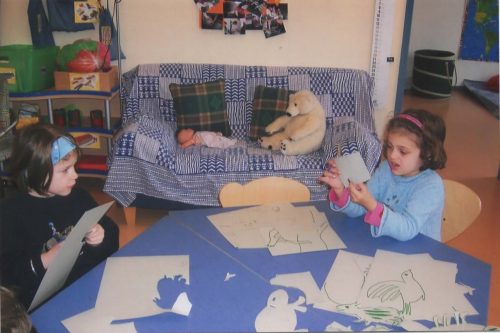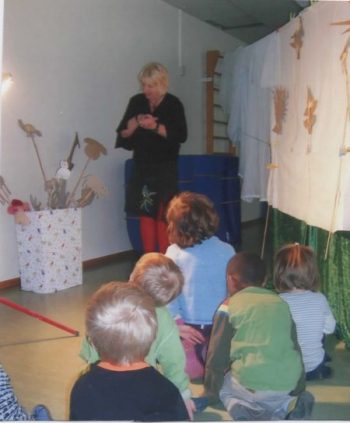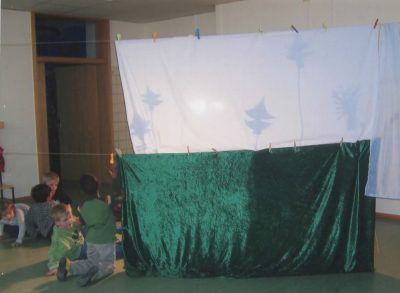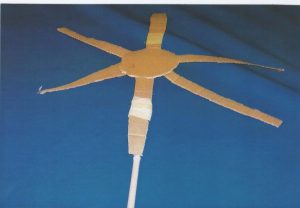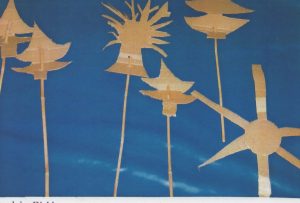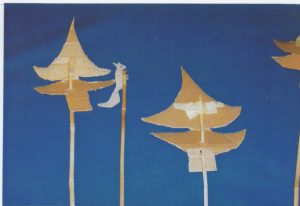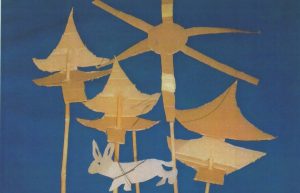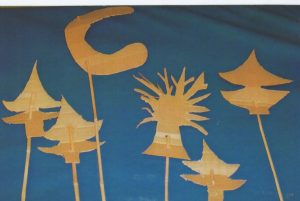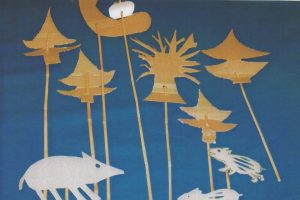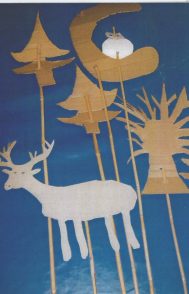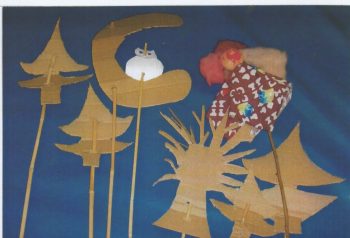by Claudia Flaig
How it all began
At the beginning of the new kindergarten year, I suggested to the team that we set up a learning workshop – following a suggestion from the IHVO Course.
The colleagues not only agreed immediately, but also actively helped to set up the workshop. Before the major restructuring of our facility, which was still imminent at the time, we could only use half of an adjoining group room for this purpose. Here there is also a reading, cuddling and building corner.
Alena – at this time 4;5 years old – immediately discovers the rearranged room in the morning and asks what is happening there. She spends one and a half hours there, most of the time alone. She picks up one game after another, looks at it closely.
Then she comes to me with the folder of worksheets and asks if she can do one of them. I explain to her that the children can now take a worksheet at any time. They are then supposed to come to a kindergarten teacher with it, discuss the tasks on the sheet and are then allowed to work them out. The rule is that the sheet should be finished. Then they are allowed to take another sheet, if they like.
From now on, Alena often does two sheets in a row. The children’s folders are on a shelf.
…in brief…
The author sets up a learning workshop with some children, including Alena (her observation child in the IHVO Course). Alena and five other children form a core group that first familiarises themselves with the material so that they can then guide the other children.
The children of the core group also participate in the first experiments. It is described how Alena then repeats an experiment with an interested three-year-old.
Together with the children, rules of use are established
The other children in the group only discover a small part of the learning workshop on the first day, some only later. After three days, we set up the rules for the learning workshop together with the children:
-
- For reasons of space, only three children are in the learning workshop (LW) at a time.
- It should be quiet in the learning workshop (this usually works despite the building corner!).
- Games are neatly put away.
- Dealing with worksheets: Select a sheet, discuss it, finish it, file it away, and only work on another sheet afterwards if desired.
- The pencils remain in the LW, they belong back on the shelf after use.
- The LW is not the painting corner – the painting table is still in the group room.
- Those who regularly do worksheets get a folder for it.
- Small children are also allowed in the LW, but only if they do not disturb.
The first equipment of the learning workshop
In the workshop, which is still cramped at first, a mattress bed with cushions serves as a reading and snuggling corner. A small table with a bench and two chairs provides the opportunity to work on the worksheets and play table games.
The initial equipment with books:
-
- Antje Damm: „Ist 7 viel?“ 〈Is 7 a lot?〉 (Moritz-Verlag)
- Philip Waechter: „Ich“ 〈I〉 (Beltz-Verlag)
- Sylvaine Perols: „Der Körper“ 〈The Body〉 (Meyers kleines Kinderlexikon) 〈Meyers Small Children’s Encyclopaedia〉
- Diercke World Atlas / and also a globe
- Angela Weinhold: „Kinder dieser Welt“ 〈Children of this world〉 (Serie: Wieso? Weshalb? Warum? Special volume, Verlag Ravensburger)
We will also put up three posters:
-
- Washable world map (by Schönhoff, Krüger and Ortmann)
- ABC poster and numbers poster (both from Beltz-Verlag)
And these games are available in our first set:
-
- Logeo
- Nikitin Material Logo
- Wer ist es? 〈Who is it?〉 (Hasbro games)
- Lotti Karotti (Ravensburger)
- Schau genau 〈Look precisely〉
- Cuboro
- Rush hour (Ravensburger/Thinkfun)
- Lesehexe 〈Reading witch〉 (Haba)
- Kleiner Rabe kann das ABC 〈Little raven can do the ABC〉 (Kosmos)
- Picture and letter cards from Würzburg Letter and Sound Training 2
- Klatschdomino 〈Clap domino〉 (Fröhling)
- Unsere 5 Sinne und die Umwelt 〈Our 5 senses and the environment〉 (Fröhling)
- Plan toys Zahlenpuzzle 〈number puzzle〉
- Magnet board with letters
Also inspired by the IHVO Course, we want to get parents involved as experts. After a short information at the parents‘ meeting, a poster is hanging in the hallway.
The learning workshop benefits from the restructuring of the kindergarten
The major restructuring and expansion of our facility, which was triggered in part by a change in the law, combined with a rebuilding project, has put a lot of strain on all of us. At least there is one advantage: now, after more than a year, our learning workshop has more space. And our director used a large part of the additional funds for furnishing and materials for the learning workshop. (Thank you!) Together with a colleague, I also took over the promotion of our preschool group, the 15 „Schlaufüchse“ 〈Clever Foxes〉, which now includes Alena again – she is now 5;8 years old.
Alena blossoms
Through the experience of keeping up with the older children and being accepted by them, Alena has become totally self-confident. This is shown to me by her open eyes. She comes into the group in the morning standing upright – in the past she often sneaked in biting her nails. Now she often has something to tell. With an all-embracing look, she checks the group situation and the day can begin.
My group has increased from 15 to 22 children. This now offers many opportunities for Alena to exercise her social skills – the only advantage of this drastic increase in the number of children! Of course, looking after five new two-year-olds is not her job. However, this way Alena is not bored when there is no activity on offer or a pleasant play partner.
Plenty of mental „fodder“ for the „Schlaufüchse“
The 15 „Schlaufüchse“ include eight age-appropriate children, four very gifted preschool children with great letter and number skills who will start school in summer, as well as Charlotte (4;5 years old), Sina (also 4;5) and Hannes (4;7), who not only have letter and number skills, but also show remarkable talents in these areas. Hannes can already read a lot, while Sina has an incredibly clever way of expressing herself. She is very calm and adapted in the group, and physically seems rather a year younger. She should get more cognitive „food“.
In the mathematical area, we mainly use the „Idea Box for Mathematical Education in the Kindergarten“ in our preschool work. (Praxisordner für die frühkindliche Bildung, Volume 9, loose-leaf collection – by Ans Veltman and Willeke ten Noever Bakker – Bildungsverlag Eins).
In the area of language and writing acquisition, we use a „Graphomotor Workbook“
(For parents, educators, therapists, pedagogues. With the story of Frede Schnodderbüchs and his friend Addi Luftikus in many colourful pictures. Authors: Antje C Loose, Nicole Piekert, Gudrun Diener – Richard Pflaum Verlag).
In addition, the „Schlaufüchse“ go to the Bonn Art Museum every Wednesday for a total of ten weeks for an art course for children. An art teacher looks at a selected work of art with the children and discusses it with them. This is followed by practical work in the museum school with a special task – without restricting artistic freedom.
In this way, I reach an important and playful learning for school preparation: What is the task? What does this task include, what does it exclude? What is expected of me, how do I implement it?
The children like going there very much, our kindergarten is already doing this course for the third year. At the end of the course, we plan an event at the kindergarten where the children present their works and a selection of artists.
Alena calls the shots with the children
Alena is now the „boss“ of the girls in our group. Even the slightly older Mariana recognises this. Power struggles rarely take place because Mariana, very smart but unfortunately completely on her own, has absolutely different interests than Alena: Barbie, jewels, boots with heels; all morning she wears a pink stole, etc.
In the learning workshop, Mariana’s talent for quickly recognising contexts is evident again and again. Even after I have spoken very forcefully and clearly to the parents three times, they do not seem to support Mariana. So it remains primarily my task to teach Mariana to organise herself so that she can then use her resources at school.(See also: When Parents Provide Little Advancement.)
With the boys, Alena is a star: she likes to fight, behaves very dominantly and makes sure that the rules are strictly observed in the crowded outdoor area. (The garden extension is to be built later.) Of course, I signal her when she oversteps her boundaries regarding her dominance; looks are enough – we are a well-rehearsed team.
When I am particularly supportive of her in the learning workshop, she often moans:
„I wonder why I’m doing all this!“
I then grin back and ask, „Don’t you like it?“
– „Sure I do!“ she then laughs back.
This agreement shows me that Alena takes the „food“ she needs at the kindergarten.
Difficult working conditions
The consequences of the restructuring of the kindergarten are still weighing on us. The kindergarten nurses now have to do another three years of pedagogical training and feel very uncomfortable. The head of the kindergarten, who is on leave, can only take on substitutes in the worst of emergencies. For weeks, our work has been characterised by the permanent absence of two to four colleagues due to illness. In addition, there are remaining holidays and training courses, if they don’t have to be cancelled.
My new colleague (she had already worked on the shadow play project) fits in perfectly with the group – and with me, as I am not the easiest person to work with. I struggle every day to do the real educational work, among the many other tasks. As I write this, my new colleague is also absent for a week. With one half-time employee, I have to look after 22 children alone for a week – I’m really exhausted.
(See: Improving Framework Conditions!)
Alena works with me to set up the extended learning workshop
There is now more space for the learning workshop in the new rooms. So far, the existing material is only roughly sorted. I go to the workshop with Alena to find out an area of interest that I could use to motivate her to become an „expert“ in the learning workshop and to get other children on board.
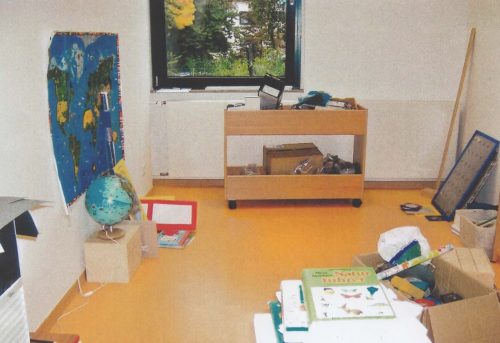
Together we sort the materials, and I try to let Alena verbalise the different areas. Although she is happy to go along, she seems a little unmotivated at first.
The following areas emerge:
-
- Equipment that can be examined and taken apart (We again have three pieces of this sort).
- Arithmetic (I suggest the term mathematics, Alena doesn’t want that).
- Geography (or world knowledge – Alena: „No, geography. That sounds better.“)
- Biology (She likes that better than „plants“ or „nature“.)
- World Knowledge (Now Alena is in favour of this term – because of a poster with planets).

Now Alena becomes more lively: „I have a booklet about planets at home – it has everything in it. We could make a sky and the globe. That would be good. I’m sure Amar and Frederik would be interested in that too.“
Then she says unexpectedly: „I used to go to gymnastics with Sina and Amar. I wonder when that will happen again?“
I am astonished: she recognises the connection between her leading of the gymnastics group, which she hasn’t asked about for a long time – it’s been over a year – and my new plans!
We still discover the „chemistry“ section among the materials. Alena sorts out different measuring beakers and jars with lids. She tells me about Peter Lustig (children’s TV serie about nature and science).
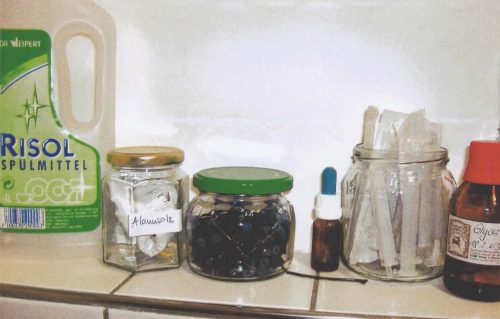
She talks about Peter Lustig (children’s nature serie „Löwenzahn“ 〈dandelion〉 on the Second German Television – ZDF), who showed an experiment with an egg. „I don’t remember how to do it. I have a DVD of Peter Lustig. Give me a note so that mum gives me the DVD to take to kindergarten. Then we can do it sometime.“ I write her the note.
The core group of the learning workshop is formed
I now tell Alena that she can explain the learning workshop to the other children together with a fixed core group under my guidance. To do this, we can first do activities in the core group from all the areas of knowledge represented.
Alena is enthusiastic and suggests – without me asking her – the following children:
Alena (now 5;8 years) – Frederik (5;10) – Amar (5;3 / Alena: „He’s quite good.“) – Charlotte (4;5) – Hannes (4;7) – Beatrice (5;8). Six-year-old Mariana and five-year-old Finn are supposed to be jumpers or take part in the second execution.
„And me?“ asks Alena, tapping on the list of names I have written. „You’re number one,“ I say, pointing to her name. „I’ll tell them right away,“ she says, beaming.
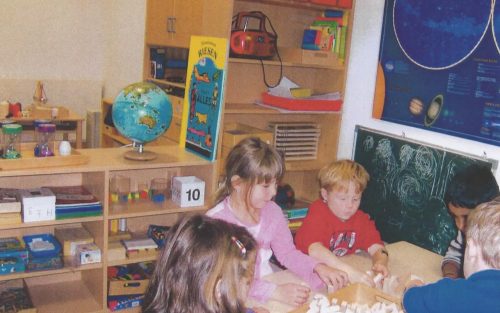
Tasks of the core group
A short time later, we go through all the areas again with this core group, rearrange the learning workshop and move on.

In a one-on-one conversation, I tell Alena my impression that she is particularly interested in space and chemistry experiments. I ask her for her suggestions about what we should do in the learning workshop in the near future. „The experiment with the egg!“ she answers without hesitation.
My goal is to keep the learning workshop permanently present for all the children in the kindergarten who can already walk. So, according to Alena’s suggestion, the first project will be „Experimenting in the Learning Workshop“. The core group, which Alena leads with my help, is to motivate the other children in the kindergarten to come to the learning workshop.
The core group should first get to know the following and pass on what they have learned:
-
- Handling the microscope,
- Use of bar scales and digital scales,
- Safe handling of (harmless) chemical substances,
- Safe handling of tools (many of them can already do this because of the previous disassembly project, but there are always new children),
- Learning first computer skills,
- Learning and following the rules of the room.
These goals are to be achieved with simple experiments according to Prof. Gisela Lück – whom I got to know in two extremely exciting lectures on „Natural Science Experiments for Children“. (We use her instructions „Was blubbert da im Wasserglas“ 〈What’s bubbling in the water glass〉 and „Neue leichte Experimente für Eltern und Kinder“ 〈New easy experiments for parents and children〉 published by Herder-Verlag).
This is just a guide for now. I think I am flexible enough to take on board the children’s impulses and to let the children’s interests and suggestions plan the course of the project as far as possible.
Hopefully, the experiments will attract the children
to the learning workshop with an enthusiasm for learning.
– It should become a small educational island in the kindergarten.
In the team, I initially „dug out“ two hours each on Tuesday and Thursday for the implementation of new experiments. Due to a lack of staff, however, I now only have one hour each for this. The experiments are first carried out on Tuesdays with the core group. On Thursdays, the same experiment follows with Alena and/or other interested children from the core group and new children, whereby very young children are also addressed here.
The children of the core group go to all groups
and approach children.
The learning workshop can be used by all children as long as they follow the rules. Experiments may also be repeated here.
First activities: making soap bubbles and plasticine
Before we start with the experiments, we watch Alena’s Peter Lustig DVD together. The many interesting contributions about nature, technology and chemistry fascinate the children.

Then Alena is absent for more than two weeks due to illness. During this time, children from the core group make soap bubble lye and wire loops for large soap bubbles without her.
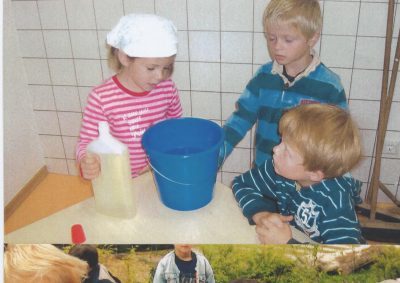
Hannes, Amar and Frederik start making plasticine on behalf of the U3 group. When Alena is well again, they show her how to do it (recipe according to Lück).
Since Frederik needs language support, I ask him to explain the steps. He explains the digital scale: „You put a piece on it, flour in it – you can see how many grams it is.“ Alena takes plasticine from the table, which is still there from the last production, and asks who made it. Hannes: „We did.“ Alena replies, „But you did a good job!“
Alena knows all the terms: electricity, gram („There are also milligrams“), kilogram, temperature, measure, weigh, litre, millilitre, powder, kettle. Through this knowledge, she is able to guide the repetition of these activities independently.
At first, the consistency of the plasticine is not firm enough. It is immediately clear to Alena that more flour needs to be added. As soon as the plasticine is ready, Alena takes the bowl and distributes the plasticine – and takes some first, which I correct. She gives instructions: „Take the leftovers from the bowl.“ I say, „Please!“ and she repeats the request more kindly.

Alena now suggests, „Now we’ll make dinner!“ To which I reply, „Can Clever Foxes also knead numbers?“ – „Okay,“ says Alena.
First the children carve numbers into the plasticine, then letters. Finally one child rolls out the plasticine in the shape of a sausage and the children form numbers and letters out of them, as well as corresponding animals: for example, E for elephant.
As Alena has problems forming a 3, Frederik shows her how. Alena praises him honestly.
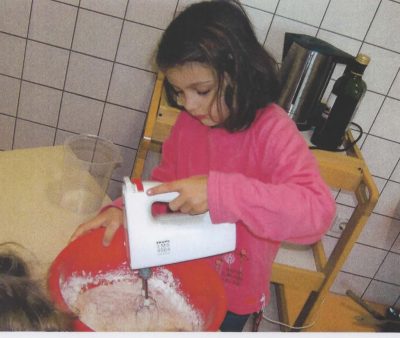
These first two „official“ activities in the learning workshop let the children recognise and assign different areas of the workshop. The children draw the recipes for plasticine and soap bubbles.
Now it’s time for the chemical experiments
After we have handed in the plasticine to the U3 group, I announce the first chemical experiment to Alena. Alena reacts anxiously: „I don’t want to play with fire. I’m afraid someone will get hurt.“ I explain to her that the children are only allowed to work with dangerous things like fire, electricity and toxic substances from the pharmacy together with me anyway.
Alena: „Yes, we only do simple experiments alone!“
I think she feels a little overwhelmed. So I make it clear to her again that she won’t do anything she doesn’t want to and that I will always be present in the learning workshop. After all, I am the teacher, not her. Alena seems relieved.
I explain to the 6 children in the core group what materials they should bring for our first experiment. The topic is: „What the eggshell has to do with our teeth“ (according to Gisela Lück’s instructions). I inform all the children about our project with a poster, which I place in a clearly visible position on the exit door.
The experiment with the eggshell
Alena suggested this experiment. For motivation reasons, this should now also be our first project. Conveniently, the „Toothbrushing Fairy with Fridolin“ was in the kindergarten only a few days before, so the children have just refreshed their knowledge of dental care.
Five children from the core group take part first: Alena, Beatrice, Hannes, Amar and Frederik.
I ask about the term „experiment“. Hannes (4;7 years old) quickly has an explanation ready: „An experiment is when you have tried something where you thought you could do it. Then you try it. Then it works – or it doesn’t.“ Alena adds: „An experiment is when a person can’t do it, but they try until they can.“
Hannes says shortly afterwards that we are researchers and that these people also do experiments.
First we familiarise ourselves with the chemical ingredients. Sniffing the tooth gel, the children realise that it is toothpaste. Smelling the vinegar, the children understand the term acid, after first thinking it was oil (perhaps because they remember making plasticine).
The first egg falls to the floor after three minutes of brushing with the tooth gel. So we learn right away to live with failure as well. Then we are more careful. The three minutes seem very long to us. Are three minutes long? „Now yes,“ says Alena. (Maybe we’ll do a time project later?).

We put the cleaned egg in vinegar.
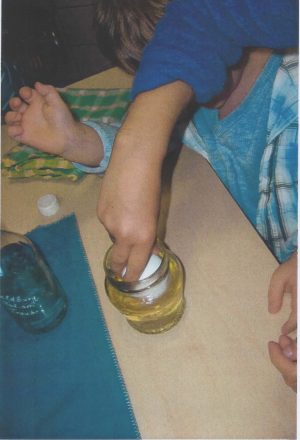
Hannes remarks: „There are bubbles on top!“ Beatrice says, „Those are gas bubbles!“ I ask about the state of the eggshell where we haven’t applied gel. Alena: „There are no gas bubbles.“ (She immediately remembered this term.) When I ask why the egg moves in the vinegar, Alena answers that it’s because of the gas bubbles and Hannes says it’s like in fizzy water.

Alena asks why the egg in the vinegar gets so thick. I ask her to look at the egg from above and below. Then she realises that it is an optical illusion because of the curvature of the (jam) glass. We watch the spectacle for another ten minutes, then we set up an „observation station“. This means that on an empty shelf in the learning workshop (with a glass window to the group room) there is now a blue fabric set; and on it we display the results of our experiments.
Alena repeats the experiment
The following Thursday, Pavel (3;3 years old) brings a jar with a hard-boiled egg. I ask Alena if she wants to do the egg experiment with Pavel. „I can do it with him,“ she agrees.
She puts all the materials on a blue set and asks Pavel to tell her what he sees. Then she says, „I’ll do it with the toothbrush then.“ I point out to her that she should let him do it himself as soon as possible. „Yes,“ she says and grins at me.
Pavel says, „We boiled the egg.“ To which Alena replies, „Yes, fine. – So, it goes like this: Take the egg out of there. I hold my hand under it. Now get the cloth out of there.“ (Pavel has brought the boiled egg wrapped in a cloth in a jar).
Alena is already about to press the tooth gel onto the egg, looks at me and then asks Pavel to do it. Pavel: „I’ll put gel on here.“ – Alena: „Yes, right. You’re doing a good job!“ She looks at me and says, „Set the alarm clock!“ I give Pavel a hand: „Please! Three dashes are three minutes. I’m sure you can set it.“
Pavel looks at me, startled, covers his ears and asks, „Is that loud? I don’t like it anymore!“

Now Alena intervenes, „You don’t have to be afraid. We just want to brush toothpaste on the egg for three minutes, because the egg comes in vinegar, which is acidic and breaks the egg. We’ll see if toothpaste really protects the teeth.“ Then turning to me: „Claudi, can you put the watch away, please. Pavel is scared!“
I’m amazed at how empathetically and wisely Alena helped Pavel overcome his fear and continue to want to do the experiment. Anyway, I set the timer in the group room. Pavel, however, remains worried. (The mother later confirms Pavel’s problem with ticking clocks to me – cause unknown. Maybe another reason for a time project?)

Pavel doesn’t hear the clock ringing and observes the gas bubbles with fascination: „There are little balls. There are no beads at the bottom.“ And then, startled, „Where is the clock?“
Alena reassures him: „Claudi took it away. It’s already expired. So, here you see beads. Here the egg has been brushed, there are no balls. You always have to brush your teeth, that protects you from Karius and Baktus. Did you hear that, Pavel?“ He nods. Alena has cleverly brought him back to the topic.
(Editor’s note: „Karius and Baktus“ is a 1954 Norwegian puppet film designed to encourage children to brush their teeth. It is based on the children’s book of the same name by Thorbjørn Egner, published in Norway in 1949. It was later published in German. The tooth devils Karius and Baktus became a symbol for children for holes (caries) in their teeth. – Source: Wikipedia article „Karius and Baktus“, retrieved 3.5.2018).
In the following, Alena demonstrates this experiment very well to the two boys Enno and Finn, who are not part of the core group of the learning workshop.
(See also: A Hen‘ s Egg, linked also at Projects on Explorations in Physics and Chemistry.)
Second experiment: Air is not nothing
This experiment immediately got about in the kindergarten; the children are very impressed. Again and again children come and repeat this experiment, in the meantime also independently. Guided by me, 17 children aged two to five experience the amazing processes. Alena is always happy to take part.
The new experiment is also another occasion to find further definitions for this kind of research. Beatrice, who has already participated in the soap bubbles, plasticine and eggshell toothpaste experiments, now says: „Experiments are things that you can try out. You can see what happens. Maybe something exciting happens, or something changes. Or something dissolves.“
A three-and-a-half-year-old girl says, „In a trial, you can mix things up.“
Once, when Alena holds the glass filled with air in the water at an angle during the second experiment, another three-and-a-half-year-old girl immediately says they are air bubbles. Then she blows in the face of a child, which of course everyone imitates: You can’t see air, but you can feel it.
„There can’t be any air where someone is sitting, that is, where the body of us is,“ I explain once. „No,“ Hannes replies, „but right around us!“ I’m really amazed at what the children say when they have the impulse for a little experiment.
Regarding bubbles, Sina (4;5) says she always makes bubbles in the bathtub: „If you didn’t have air, you’d be dead.“ Since I brought Sina to the „Schlaufüchse“ (preschool group), she keeps talking about the topic of death (Should I plan a project on: clock-time-death?).
(See also: Adrian Takes to Reading the Newspaper – Questions of Life and Death).
I offer every younger gifted child a place in the „Schlaufüchse“, even if the colleagues – concerned about equal treatment of the children – are not enthusiastic about it.
Later, I witness three boys repeating the experiment on their own. One of them says: „At home, all the glasses are full of air“. One replies, „At our house, I think so, too.“
The experiment is further developed with a tealight case and gummy bears.
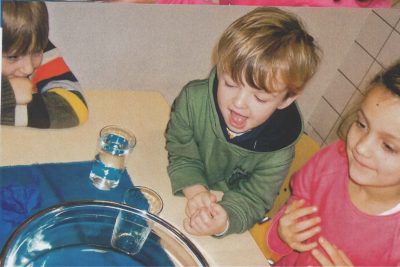

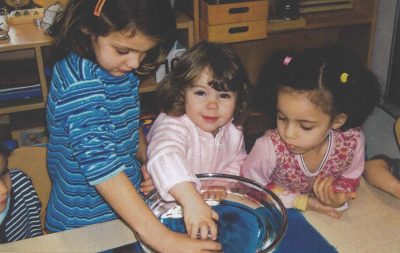
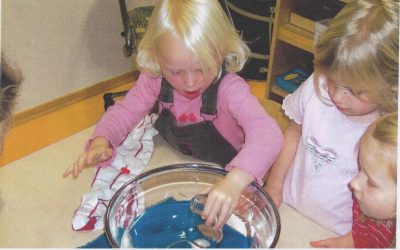
Third experiment: Not all liquids behave like water
Based on Gisela Lück’s instructions, I let the children in the core group develop the topic of this experiment largely on their own.
Alena (5;8), Hannes (4;7), Frederik (5;10), Mariana (5;11), Amar (5;4) and Caro (3;6) take part in the first experiment. Caro, who was not initially nominated for the core group, now often takes part. She would like to take part every time. She presses her nose against the glass in front of the observation station when she has to learn that others have to have space too.
When decanting the water, the children immediately realise that water from different containers mixes – Alena: „Water moves.“ Sina: „It’s liquid.“
What other liquids do they know? First the children name typical ones like limonade or milk. After I ask them to look around the learning workshop, „dishwashing liquid“ comes from Amar and „glycerine“ from Mariana. Hannes says, „Candle wax mixes with water.“ Alena agrees. I suggest we test this thesis.
So we start the experiment. Alena lights a tea light with me. „We’re waiting for thin candle wax,“ she explains. „For liquid,“ Mariana corrects. Grinning, Hannes says, „What if you put fire in water?“ I pass the question back to him. Hannes: „Then it’s over.“
I notice during this activity that this group really lets everyone have their say – otherwise Mariana finds this particularly difficult.
While we watch how the candle wax changes in the tea light, Amar explains that ice also melts in the sun. Alena then pours the hot, liquid wax into the water and says to Frederik, „Quick, stir!“ But of course the wax becomes solid and cannot be mixed with the water. Frederik puts the spoon into the glass and Amar draws attention to the rise in the water level. I explain that the spoon needs space and pushes the water away. „I see,“ Amar replies. Hannes is then allowed to extinguish the tea light with a tablespoon of water.
So the children themselves have already given some impulses in advance.
Then comes the question of whether oil mixes with water. Each child takes a glass of water, oil and a teaspoon. Alena: „Something happened with me: it doesn’t mix at the bottom, only at the top.“ Hannes: „I’m getting a ribbon!“ When I ask them if the ribbon is mixed with water, they all say no.
Alena: „Oil is circular!“ – Sina: „Oil looks like bubbles!“
Then the children add washing-up liquid and observe that the oil now mixes with the water. Great amazement on all sides! Then I explain to all the children individually, using the diagrams in the Lück book, the principle of the solubility of oil in water by teaching them about washing-up liquid.
Fourth experiment: A self-made fire extinguisher
This experiment fits perfectly with the impulses of the previous one. We also want to demonstrate it to the parents at our group Christmas party. As usual, all the materials are on a set on the table.
Alena knows baking powder. The vinegar is mistaken for oil. But after smelling it, they recognise the vinegar. „The most important liquid is water!“ says Sina.
Alena joins me again in lighting the tea light. Of course, we talk about the dangers of experiments again each time.
Alena smothers the flame with a glass. When I ask what a flame needs to burn, they all say in chorus: „Air!“ I am always amazed – though a real loser in science….
So by taking away air we can extinguish. At least I remember that in a fire you should close windows and doors, if that’s still possible, because the draught the fire still intensifies.
Then we mix baking soda with vinegar and extinguish the flame just by being near the slightly effervescent mixture. „There’s something in the baking powder!“ says Hannes.
We hold a spoonful of baking powder to the flame. Or is it the vinegar? We also hold a spoonful of vinegar to the flame.

„There’s something in the fizz that puts out the flame,“ says Alena. „Another gas,“ I reply. „What vegetables do you know? In the same way, there are different gases. Air consists of a mixture of gases. This gas that puts out the flame is called ‚carbon dioxide‘. It is heavier and pushes out the flame.“ (Carbon dioxide displaces the oxygen gas needed for burning, which is present in the air).
Repeating the experiment with other children, a boy says, „There is also a gas in the balloon at the funfair.“ I say, „Yes, it’s called helium. What do you think: Is it heavier or lighter than air?“ – „Lighter, it flies!“ some children reply. Not bad for five-year-olds!
Rules for the learning workshop
After the first experiments, we now make firm rules about how we should behave in the workshop. We talk about them before all experiments. We plan to hang a photo poster on the door, where you can see what is allowed and what is not allowed. That way all the children will know about it.
These are the rules we have collected and specified so far:
-
- Let them know you are going to the learning workshop (LW).
- You are not allowed to play on the computer for too long because it can be unhealthy.
- Some table games can be played without being asked – two shelves are filled with them.
- The „Schlaufüchse“ (members of the pre-school group) are allowed to be alone in the learning workshop, but they also have to let us know beforehand.
- Equipment may only be taken apart with the consent of the kindergarten teacher.
- Chemical experiments with fire, acids, powders and salts may not be done alone.
- Non-hazardous experiments may be done alone.
- When we have finished, everything must be tidied up again especially well.
- The observation station may always be visited.
- „Günter the skeleton“ is not touched.
The „experts“ of the core group help to ensure that the rules are observed.
Parents are informed and help
As there is always a poster in the hallway with a copy of the current experiment, parents are informed and can get involved themselves if they wish. Parents from my group and other groups come to see me regularly. They ask about the progress, whether we still need materials, whether their child can also participate and much more.
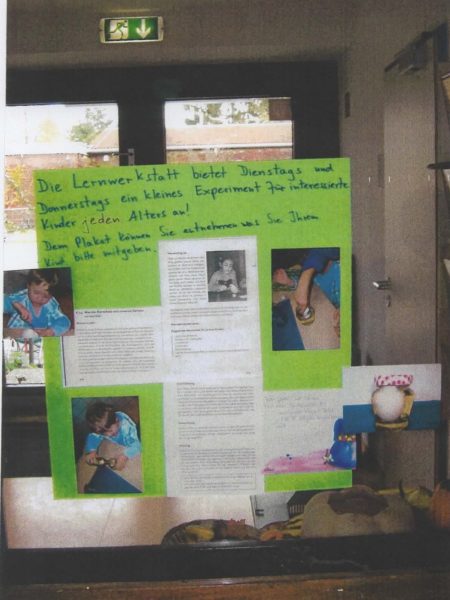
In this way, we have been given a computer with a flat screen, two computer tables and a skeleton model („Günter the Skeleton“). Also important little things like pipettes, syringes (without needles!), jars with screw caps, eggs, baking powder, ink cartridges, candles, tea lights…
Parents take part – an example: Early in the morning, a father comes to me excitedly in the learning workshop and calls out: „Are you doing an experiment right now? It totally smells like benzene in the entrance!“ However, it is only the coat of a mother who has spilled petrol while filling up the tank…. But I am a bit proud!
Finn’s mother is a primary school teacher. She wants to give a maths lesson like at school and then also go into the content of a current experiment. Caro’s father offers to build an electric circuit soon.
The learning workshop has become a real
an integral part of our day-to-day life at kindergarten!
You can also follow Alena’s advancement, as far as it is documented in the handbook articles, chronologically over almost two years:
Alena, 4;1 Years Old
Alena (4;8) Leading a Small Gymnastics Group
Alena (5;0) Studies Letters – When Should She Enroll at School?
The Dead Mother of Pompeii and Crayons for South Africa
Alena (5;2) Gets to Know the Shadow Theatre
Disassembling Electric Devices
and at the end the present contribution belongs:
Alena (5;10) and a Small Group Are Becoming Experts of the Learning Workshop
Date of publication in German: May 2018
Copyright © Hanna Vock, see imprint

























